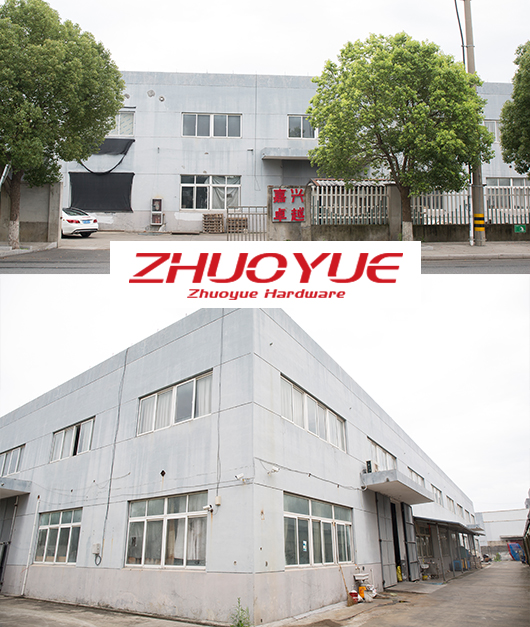Stainless Steel
Sheet Metal Parts Manufacturers
-
 View More
View More
Stainless Steel
-
 View More
View More
Stainless Steel
-
 View More
View More
Stainless Steel
-
 View More
View More
Stainless Steel
-
 View More
View More
Stainless Steel
-
 View More
View More
Stainless Steel
-
 View More
View More
Stainless Steel
-
 View More
View More
Stainless Steel
-
 View More
View More
Stainless Steel
-
 View More
View More
Stainless Steel
-
 View More
View More
Stainless Steel
-
 View More
View More
Stainless Steel

About
Jiaxing Nanhu District Zhuoyue Hardware Factory Is China Stainless Steel Parts Suppliers and China Sheet Metal Parts Manufacturers. Jiaxing Zhuoyue Hardware Company, We are a metal stampings for parts Manufacturer was founded in 2006, main products are various kinds of hardware for power utility and home appliances. The annual capacity for TV bracket exceeds 1,10 0,000 pcs. After having emotional management for over 17 years, we have developed a mature operation team and an experienced technical team to develop samples according to sketch with competitive price and high quality, on-time delivery. Also provide professional advice and solutions.
Customization
We can develop and produce products according to the drawings or samples the customers offered.
Quality & Cost
We have our own production and processing facilities, which are directly sold by manufacturers and offer high-quality and affordable products.
Media & Events
Company News

Hardware accessories are essential tool consumer goods for people's daily lives
Hardware accessories refer to machine parts or components made of hardware, as well as some small ha...
Industry News
-
The horizontal adjustment function of the TV stand: the art of optimizing the viewing experience
In the modern home environment, the TV is the center of family entertainment and information acquisition. Its placement and viewing angle directly affect the qu...
-
Wear resistance: the key to the durability of hardware accessories
In daily life and industrial production, hardware fitting are key components for connection, support or movement, and their performance directly affects the sta...
-
Sheet metal parts: the dual guardians of strength and rigidity
In the vast world of modern manufacturing, sheet metal parts have become an indispensable cornerstone in many product designs with their excellent physical prop...
-
Sheet metal parts: multifunctional guardians in final products
On the vast stage of modern industrial manufacturing, sheet metal parts have become an indispensable part of many final products with their unique advantages an...
Industry Knowledge
What are the primary applications and industries that rely heavily on stainless steel sheet metal parts?
Automotive Industry: Stainless steel is used in vehicle components such as exhaust systems, decorative trim, and structural parts for its corrosion resistance and sleek appearance.
Aerospace: Stainless steel sheet metal parts are used in aircraft components, including aircraft frames, structural elements, and interior fittings, where durability and resistance to harsh environmental conditions are crucial.
Construction: Stainless steel is a popular choice for architectural and structural applications, including cladding, roofing, handrails, and decorative features due to its aesthetic appeal and resistance to corrosion.
Food and Beverage Industry: Stainless steel sheet metal is the standard material for food processing equipment, kitchen appliances, countertops, sinks, and storage tanks because of its hygienic properties and resistance to food acids.
How do design considerations, such as thickness and geometry, impact the performance and cost of stainless steel sheet metal parts?
Thickness:
Performance: The thickness of stainless steel sheet metal parts affects their strength and stiffness. Thicker sheets are generally stronger and more rigid, making them suitable for load-bearing and structural applications. Thinner sheets are more flexible and lightweight, making them suitable for applications where weight is a concern.
Cost: Thicker stainless steel sheets are more expensive due to the higher material costs and increased machining or forming requirements. They also require more energy for cutting and shaping, contributing to higher production costs.
Geometry:
Performance: The geometry of a sheet metal part can impact its functionality and performance. Complex geometries, such as bends, curves, and embossing, can be achieved through precision forming and machining processes. The design should consider how the geometry will affect the part's structural integrity, durability, and functionality.
Cost: Complex geometries often require specialized tooling and equipment, which can increase manufacturing costs. Additionally, more intricate designs may result in higher scrap rates during production, affecting material utilization and costs. Simple, uniform geometries are generally more cost-effective to produce.
 English
English 中文简体
中文简体









